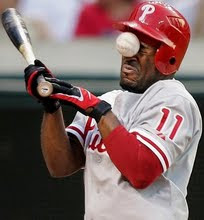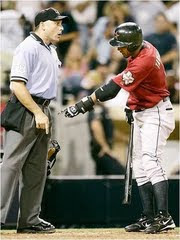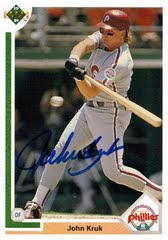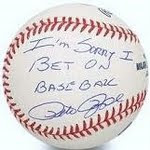This sets up the 2010 Braves rotation as Hudson-Hanson-Lowe-Jurrjens-Kawakami. Not bad, but it could be better. Why? Lost in this mix is a hidden gem: Kris Medlen.
Kris Medlen, who dominated the minors in 2009 (1.66 FIP, 10.51 K/9, 2.39 BB/9 in AAA last season), was called up a few weeks prior to super prospect Tommy Hanson. In 4 MLB starts, Medlen posted an ugly 6.38 ERA, but the underlying numbers show something better. Despite his struggles with command when promoted (5.40 BB/9 in his 4 starts), Medlen still managed to fool his share of hitters (9.33 K/9, 77.8% contact rate (80.5% MLB average)) and keep the ball in the yard at a respectable rate (0.98 HR/9, 1.05 MLB average). Beneath the ugly ERA was a much less ugly 4.57 FIP/xFIP. After being moved to the bullpen, Medlen's contact rate fell to 75.3%, his strikeout rate rose to 9.67 per nine and the walk rate, which only once (AA, 2007) eclipsed 2.63 per nine in the minors, fell to an MLB-average 3.47 per nine.
The result? A stellar 2.89 FIP/3.38 xFIP in 49.1 IP from the pen. Medlen posted the 19th best FIP and 25th best xFIP of all MLB relievers who tossed 40+ innings last season (out of 176 RPs). By comparison, super closer Joe Nathan posted a 2.88 FIP last season. Yeah, Medlen is just that good. As the season progressed, Medlen just got better. Below are graphs for Medlen's K/9, BB/9, K/BB, and ERA as the season progressed (click the image for a clearer picture).

Though Medlen showed signs of fatigue as the season wound down, there is a clear trend of improvement in his numbers from May to mid-September. Despite these clear signs of improvement, the Braves kept Medlen banished to the bullpen (where he was effective, but underutilized). Since being promoted to a starter's gig in 2008, Medlen has posted a 2.87 FIP in AA and a 1.66 FIP in AAA, while sporting a K/BB of 4.44 and 4.40 at each respective level. Using his minor league numbers, Medlen's major league equivalent FIP as a starter in 2008, per Minor League Splits, was a solid 3.82. MLE data for 2009 is not available for Kris Medlen, but his luck/park neutralized FIP in AAA last year was 2.42.
Medlen sports three pitches: a devastating change up, a quality fastball and a league-average curveball. His arsenal is so effective not just because of the quality of his stuff, but also the effectively deceptive nature of his release point. Medlen's release point for his Fastball, Curveball and Change Up tend to look like this (taken from Medlen's 5/31/2009 start vs the Diamondbacks, click the image for a clearer picture):

What is noticeable here is a mix of pitches thrown from an almost identical release point, each with a sharply different level of velocity and movement. Such is how Medlen is able to so effectively fool hitters.
The moral of the story here? Kris Medlen is very good. He is much better than Kenshin Kawakami and Jair Jurrjens and probably even Derek Lowe and Tim Hudson, despite the ERA disparity. The Braves are wasting a golden arm. If given another chance to start, Medlen could be one of the best fantasy sleepers for 2010.







19 comments:
you've convinced me medlen is good. you've also convinced me that xFIP is retarded
we are made to believe that the pitcher can only control K, BB, and HR rate, yet we choose to normalize the HR/FB, so that just leaves K/BB. May as well just call xFIP K/BB
The theory behind xFIP is that a pitcher controls the TYPE (GB/FB) of contact, but not the strength of contact. It's not like a pitcher says "albert pujols, you are only allowed to lightly tap this pitch"
and xFIP is based on a pitcher's FB%; it's not arbitrary.
so did greinke get lucky with the home run ball last year? based on xFIP, yes he did, cause even Greinke and his 10 WAR season cannot control how hard someone hits a fly ball
Yes, he did. Do you know any other guys with a 40% GB rate and sub 0.50 HR/9 rate??? Only Clayton Kershaw, whose 4.1% HR/FB ratio was the absolute lowest in the majors last season (coupled with a 77+ LOB%, I smell Greinke-like luck).
here are the comparable batted ball guys (within 1% of Greinke's GB%) from 2009:
Edwin Jackson (39.1 GB%, 1.14 HR/9)
Clayton Kershaw (39.4 GB%, 0.37 HR/9)
Randy Wolf (39.6 GB%, 1.01 HR/9)
Matt Garza (39.7 GB%, 1.11 HR/9)
Cole Hamels (40.4 GB%, 1.12 HR/9)
Jeff Niemann (40.5 GB%, 0.85 HR/9)
Ross Ohlendorf (40.6 GB%, 1.27 HR/9)
Livan Hernandez (40.6 GB%, 0.93 HR/9)
Joe Blanton (40.6 GB%, 1.38 HR/9)
There is also Jonathan Sanchez (40.7 GB%, 1.01 HR/9)
I used GB% as the comparison because non-GBs are what turn into HRs, so its a better basis for comparison than FB% (especially given the variable classification of LD% by park -- http://www.fangraphs.com/blogs/index.php/what-i-hate-about-line-drives/)
Greinke and Kershaw also happen to have filthy unhittable stuff, much more so than all the other guys you mentioned
Why do you think the pitcher controls the strength of the contact the hitter makes? Once the ball is out of his hands, its out of his control. It is then the batter's guess to eye the pitch and make the contact. Filthy stuff or not, it's the batter's ability to make contact at that point which determines the strength of contact, not the filth of the pitch. Yes, filthier pitchers may have harder to hit stuff and lower ISO's against (and lower contact%), BUT a 4% HR/FB rate is absurdly low. Its not like IFFB are a skill (but don't tell that to Oakland Zito)
and if you're really this critical of xFIP, then you should reaaaally love tRA.
In short, a pitcher controls a few things in my surmise;
BB's -- the data and intuition is obvious and thorough
K's -- Pitchers with deceptive stuff miss more bats. A pitcher controls how deceptive his pitch will be. K's are seemingly less within the pitchers control than BB's because the batter element exists less with walks (unless it's Jeff Francouer at bat)
GB% -- A pitcher can influence a hitter getting on top of the ball by increasing break, slope and rotation of the ball/its trajectory.
FB%/LD% -- it is hard to say whether or not a pitcher's offering will be a FB or LD% because that is largely dependant on the strength of contact, but it is within the pitcher's apparent control to influence a hitter to get under the ball.
HRs are outside the pitcher's control because a HR is just a LD/FB that is hit with authority (something the pitcher does not exercise a great deal of control over)
fuck, i was gonna bring up your Zito IFFB argument but you beat me to it.
And the pitcher absolutely has control over how hard a hitter's contact is. Have you heard of Greg Maddux? 0.63 HR/9 career. He had a season of 0.18 HR/9!!! And his stuff wasnt even that filthy, he just never made a mistake. Mistakes get hit hard
also it helped that he didnt give up fly balls. that reminds me, I want brandon webb on the cubs. If he walked one less guy per 9, he'd be greg maddux. I like how his xFIP is lower than his FIP, such that he's actually been unlucky with the homerun ball despite having a career 0.63 HR/9
Greg Maddux was also a GB pitcher who kept the ball on the ground over 50% of the time.
More GBs=lower HR/9. However, in theory, the HR/FB rate should remain static.
Sadly, batted ball data is limited before 2002. Perhaps in a decade or so, we can revisit this argument and run a correlation analysis on HR/FB rates from year to year.
Using Fangraphs' 3 year time frame data, I found only 9 starting pitchers with HR/FB rates under 7% who pitched 200+ innings in that 3 year span. Of them, we see several names (Carpenter, Kelvim Escobar, Dallas Braden, Clayton Kershaw) with very limited sample sizes (under 300 IP) and another (Chris Young) who has a limited sample size and plays in Petco.
In fact, all but about 40 of the names in this list have HR/FB ratios that range from 9% to 12.7%.
If we could look at an 8 year sample size with 1000 IP min., i bet the variance would decrease.
But we can both agree: Kris Medlen is very good (almost Tommy Hanson good). Right?
I actually found a way to look at all of the 2002-2009 batted ball data. There are 73 pitchers who threw 1000+ innings between 2002 and 2008. Of them, only Jason Schmidt (7.5%), CC Sabathia (8.4%), Cliff Lee (8.5%), Barry Zito (8.6%), Mark Redman (8.8%), Jarrod Washburn (8.8%), Roger Clemens (8.9%), Pedro Martinez (8.9%), Brandon Webb (13.2%), and Brett Myers (15.5%) -- at total of 10 pitchers -- did not fall into the 9%-12.7% HR/FB ratio range.
Of them, Lee, Sabathia, Zito, and Washburn pitched at exteme HR suppressing parks for a lot of the sample size, while Webb and Myers pitched at extreme HR exaggerating parks.
Perhaps, it is true that pitchers with better "stuff" have relatively lower HR/FB rates, but there is no indication that its a true or significantly sustainable skill in the 8 year sample size.
Perhaps, as I've suggested before, a better way to determine xFIP would be weighted based on park dimensions. However, this seems to be a daunting task and for now, what we have will do
to look at the data, btw, here is the link:
http://www.fangraphs.com/careerleaders.aspx?pos=all&stats=pit&type=2&min=1000
I wonder if Medlen just has "bullpen stuff" and not "starter stuff." Guys like Joe Nathan are phenominal bullpen guys but horrible starters and the statistical disparity could just be that Medlen flat out can't pitch 6 innings every 5 days. Now there's an obvious sample size problem but I don't think this data you've given us automatically means Medlen should start. I agree he probably should be given another chance, but you haven't fully convinced me that he'll do wonders if given the chance again. Just because Medlen has three pitches does not necessarily mean he should start- it certainly helps his chances that he has more than two- but as Cole Hamels and Joba Chamberlain/ Phil Hughes has shown me- the number of pitches does not equate to whether the pitcher should be a starter or not. Plus, I bet if you did an analysis of Hughes or Chamberlain's numbers b/w their bullpen numbers and their starter numbers, you could find a conclusion similar to Medlen. Yet I don't think either Hughes or Chamberlain should start for the Yankees. Just because a player has good bullpen numbers, does not mean they will have good starter numbers- which seems to be the conclusion you make.
Also, I agree with TBO that xFIP seems dumb- but I also thought the same thing about sabermetrics too so I'll admit that it could fully be based upon my ignorance. But the fact that FIP is fairly theoretical (because we DO have defenses and the reality is a ball does land somewhere whether its in a defenders glove or the ground), and then add what a theoretically what a theoretical stat is just seems like a good way to measure a guy for fantasy and not for reality. I ask that you not comment on this seeing the ten comments you already put that would disagree with me, but I know this is a fruitless task and you'll do it anyway
Couple of things:
1) Phil Hughes should also be starting. He's also been the victim of poor luck.
2) Kris Medlen had fantastic stuff as a starter. He was just honing his command. His K/9 as a starter was >9. His BB was just in the low 4's and his LOB% as a starter was 62% (72% lg avg). He's not a bullpen only guy. I bring up the 3 pitches only to show he's got 3 good pitches that are very deceptive. Not bc all 3 pitch guys are/should be starters
3) I don't think xFIP is stupid because non-GBs are home runs. Pitchers dont control how hard a ball is hit, only the tendency of it to be on the ground or in the air. Thus, it makes perfect sense that HR/FB rates normalize based on park dimensions and lg avgs.
4) Too bad, i just commented
DME, we concluded that a pitcher does have control over how hard the pitch is hit. A small degree of control, but small differences between pitchers equates to large differentials on runs allowed
Hamels, Hughes, and Chamberlain should all be starting. I dont know what sexy rexy is talking about. Matter of fact, Rafael Soriano should be starting. He started in seattle, where he was unhittable until his injury. I would put him back in the rotation Ryan Dempster style
Post a Comment